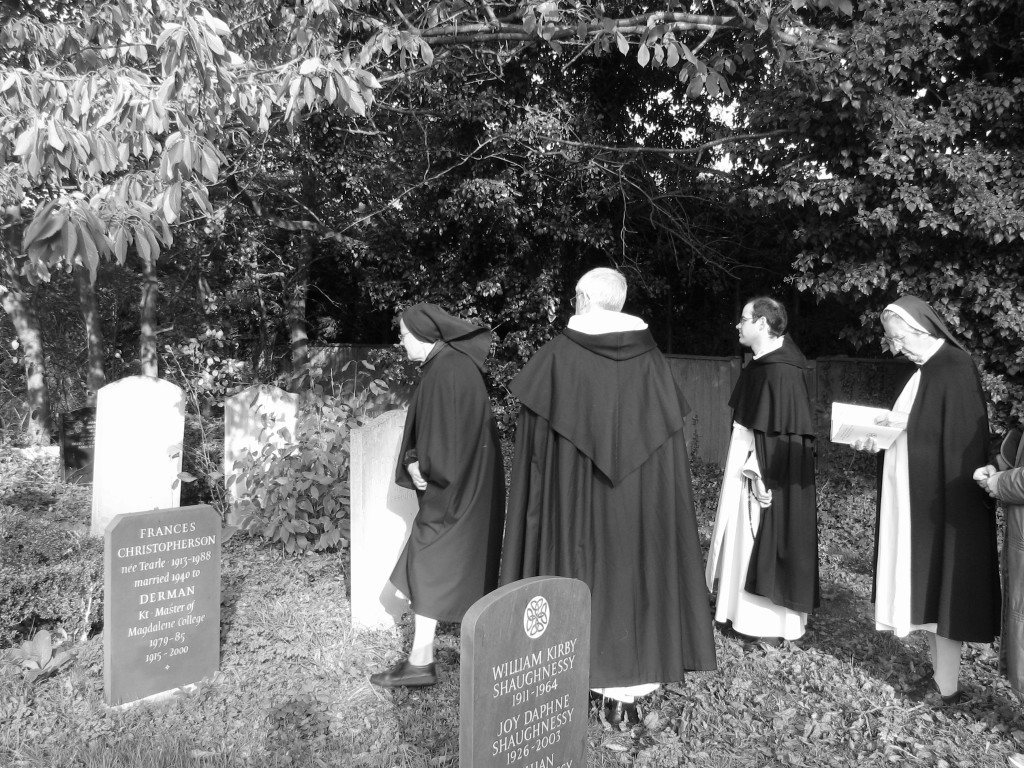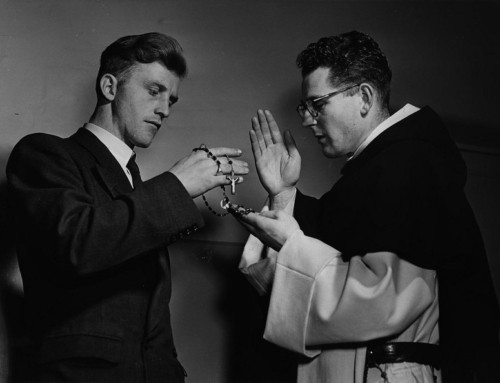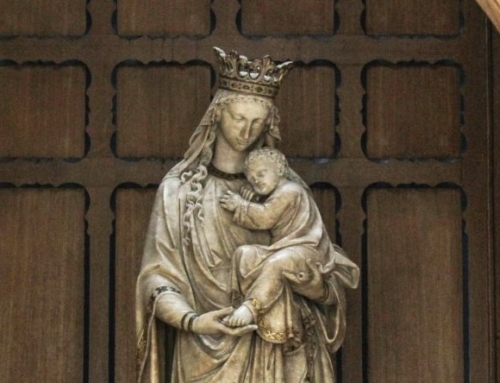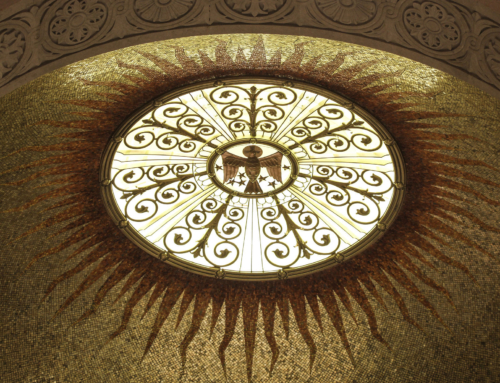Our Fundamental Constitution, a basic overview of Dominican life, states, “The Dominican family is composed of clerical and cooperator brothers, nuns, sisters, members of secular institutes, and fraternities of priests and laity.”
The term “family” can be used in many different ways: nuclear family, extended family, my college family, my work family. Its use abounds in the Church in particular, both in rites (e.g. “Pray, brothers and sisters”) and in common parlance (e.g. “Good morning, Father Paul”). Every metaphor and analogy begins with some model or primary referent. What model, what image of the family do all of these refer to? According to St. Paul, the use of familial imagery is rooted in the Heavenly Father: “For this reason I kneel before the Father, from whom every family in heaven and on earth is named” (Ephesians 3:14-15).
Family properly so called
In the course of developing his Theology of the Body and in the apostolic exhortation Familiaris Consortio, Saint John Paul II presents a beautiful image of the family as a community of life and love. Although the foundation and archetype of all human communion is the Holy Trinity—a union of love between Lover and Beloved so strong that the very Love between them is itself a Person—the specific community of the family “is a sign and meeting place of the loving covenant between God and man, between Jesus Christ and His bride, the Church.” In a natural family, bridegroom and bride, lover and beloved, join together and manifest the fruit of their love in children. Father, mother, and child united walk together to be fulfilled in the Kingdom of God.
Families have the fundamental task of serving life, “actualizing in history the original blessing of the Creator—that of transmitting by procreation the divine image from person to person” (Familiaris Consortio, 28). Families flourish and grow in love and life until they are ultimately fulfilled in the infinite and eternal life and love of the Lord. The man and woman welcome the new human person into being and introduce the child, by education and the sacraments, into the human community and the Church. With this beautiful image in mind, John Paul II charges the family with the mission “to guard, reveal, and communicate love” through sacrifice.
Dominic’s Two Families
So, how does the Dominican analogy of family correspond with St. John Paul II’s theology of the family? The answer lies in the person of Saint Dominic. Saint Dominic clearly had a loving natural family. According to thirteenth-century sources, Dominic’s parents were “good and pious,” his father, Felix, was a “man looked up to by the villagers and the wealthy” and his mother, Blessed Jane of Aza, was a woman “virtuous, chaste, prudent, full of compassion for those who were unfortunate and in distress.” Their charity in Dominic’s youth planted in him the seed of the generous spirit which would flourish for the rest of his life. In educating their children, Felix and Jane instilled in them the virtues, setting their feet on the path to God.
We, on the other hand, are a part of St. Dominic’s spiritual family. As St. John Paul II taught us, the communion of the family is founded on the relationship among father, mother, and children. Our Dominican father is St. Dominic. Bl. Jordan tells us of the many nightly vigils our Holy Father would keep, first checking on the brethren to make sure they were comfortable, and then staying up through the night to intercede for them. Through his prayers, he still provides for, guides, teaches, and chastens his sons and daughters on earth. Among the lessons he teaches us is love for Mary. Dominic constantly reminds his children of the Mother given to us by Christ on the Cross, who watches over her sons and daughters. She teaches us to contemplate as she did, to carry His Word in our hearts, and give birth to Him in our preaching.
From One Generation to the Next
We are products not just of our parents and our times, but of the whole familial culture which proceeds us. C.S. Lewis in Prince Caspian emphasizes how we, as sons and daughters of Adam and Eve, bear “honour enough to erect the head of the poorest beggar, and shame enough to bow the shoulders of the greatest emperor.” We inherit more than just genes and a name from our ancestors. Even if their individual story is lost, their lessons live on in the culture we inherit from our parents. For instance, I am proud of my heritage. The various values of my family—such as an exploring spirit, a gentle warmth towards all, valuing silent consideration of nature’s marvels—makes up the culture that formed me as a man.

Photo: Lawrence Lew, O.P.
So too with the Dominican family. We are born of the heritage given us by our Holy Father through men and women like Jordan of Saxony, Martin de Porres, Savonarola, Pier Giorgio Frassati, Charles Louis Richard, Vincent Jandel, Peter Gonzalez, Catherine of Siena, Agnes of Montepulciano, Rose of Lima, and Imelda Lambertini. This tradition has grown through them and through many unknown brothers and sisters as well, and today it continues to be passed on to us.
A Sacrificial Love
A good and loving family forms a strong foundation for a child, and it is natural for the child, once grown, to carry on this love to a new generation of his family of their own. The love the child shows as he matures stems directly from the love that he himself was shown. The family is our first way of knowing love and coming to understand what it means to be alive. Dominic had a healthy loving family himself and knew this love. Rather than give all his love to raise children of his own in the natural order, however, he sacrificed this highest of natural goods for the sake of the Kingdom. The love that he knew from his biological family he poured out on his family in the spiritual order. By renouncing marriage for the kingdom, he and his sons and daughters highlight the meaning of marriage and its beauty. Only from a great sacrifice can you bear great fruit, and the fruit of this sacrifice was the vast spiritual family of the Dominican Order.
And yet, even in this sacrifice, he did not lose his first family; rather, he drew them also into a greater family, a spiritual family. The perfect example of this elevation of his natural family into the spiritual order is his brother Mannes. Blessed Mannes was likely a few years older than Dominic. I can just imagine the two of them growing up together, Mannes leading and little Dominic following in his big brother’s footsteps. As the two of them grew, however, it ended up being Mannes who followed in his brother’s footsteps. He was one of the earliest members of the Order and through deliberately becoming a part of this spiritual family, made his way to Heaven. This same spiritual bond stretches through the natural relationship Dominic had with Bl. Jane, Felix, and Antonio, another brother who became a priest, even though they never made the conscious decision to join the Order. They were yet associated with this spiritual family through their son and brother. And just as the Blessed Mother is highly blessed for hearing the word of the Lord and doing it with a loving heart, so too is the biological family of Dominic—and often the biological family of each Dominican—sanctified by their part in the formation of their son or daughter.
Throughout the generations, this family of St. Dominic has sought to have “one heart and one mind seeking God,” as stated in Acts 4 and repeated in the Rule of St. Augustine. Dominicans seek to live in this mutual bond of sacrificial love, and this is the fruit of Dominic’s sacrifice: a family of 800 years of men and women dedicated to the love of God and His children. Dominic’s sacrifice of one small earthly family won for the world a great family within the Church. From pouring out all his love as a libation before the throne of God, Dominic brought forth by God’s grace a family of preachers. As the flask of the Magdalene must be broken and poured out upon the feet of Christ in order to fill the house with its fragrance, so Dominic, taught by the love of his natural family, sacrificed the good of natural familial love to found a family whose fragrance has spread to the ends of the earth.
O Spem miram, quam dedisti
mortis hora te flentibus,
dum post mortem promisisti
te profuturum fratribus:
Imple Pater, quod dixisti,
nos tuis iuvans precibus!
O wonderful hope which you gave at the hour of your death to your weeping brothers, promising that after your death you would aid them greatly: Fulfill Father what you have said, helping us by your prayers!
To download a printable PDF of this Article from
Dominicana Journal, Summer 2016, Vol. LIX, No. 1, CLICK HERE.



